
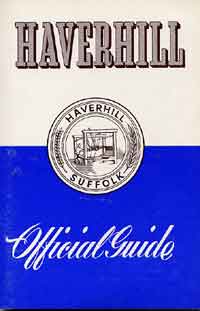 Guide Book 1964 Guide Book 1964 |
Haverhill
From the Iron Age
to 1899
|
2000 BC
|
Haverhill lies along two valleys. The main one runs from north-west to south-east and the smaller one is on a south-west to north-east line, with the town centre standing by the junction of two small streams, neither of which is dignified by having a proper name.
The larger of the two streams is known as the Stour Brook because it joins the Stour proper about two miles south of the town, at Wixoe.
Habitation of the area is very ancient, as borne out by traces of Stone Age occupation which have been found.
|
|
150 BC
|
A succession of coins manufactured by the tribes of Northern France was imported into south-east England beginning around this time for at least a hundred years. This area of France has been called Belgica, and these coins are known to collectors as Gallo-Belgic A to F series. In the past this evidence was thought to indicate successive waves of Belgic invaders, but this is no longer widely believed. Although Caesar recorded Belgic raiders to England who may have settled there, it is now thought to indicate payments for military service, close cultural links and trading ties as well as gifts cementing political or social alliances across the Channel.
|
|
60 BC
|
A few Iron age artefacts have been discovered in the area.
It is thought that there were two separate peoples in Suffolk at this period, with a boundary roughly from Newmarket to Stowmarket and Aldburgh. To the north were the Iceni, and in the south the Trinovantes. Their names are known from Roman writers. The iron age Iceni tribal heartlands were in North West Suffolk around Ixworth and the Blackbourne Valley and Icklingham, West Stow and the Lark Valley.
|
|
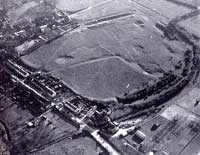
Erbury Camp at Clare |
|
|
In South Suffolk, Clare Camp, formerly Erbury, may have been an iron age fort of the Trinovantes but no archeological evidence exists for this idea. These people also had a settlement at Long Melford and this Stour Valley group looked to Camulodunum next to where Roman Colchester arose. They were known as Trinovantes and because of their origins are also called the Belgic or Belgae tribes and were possibly late arrivals from the Continent.
They were an organised society able to produce luxury goods such as the gold torcs found at Ipswich.
|
|
55 BC
|
Julius Caesar led his first expedition to Britain, probably just after the Roman Empire began the conquest of Gaul. Julius Caesar wrote down his experiences in his book on the Gallic Wars, "De Bello Gallico". Many of his
comments contribute to our knowledge of the time. He wrote that one of his opponents was King Diviciacus of the Suessiones in Belgic Gaul and that he previously had control over a large area of Britain. This supports the idea of close links between Britain and Belgica around this time.
|
|
54 BC
|
Caesar's second expedition to Britain resulted in the surrender of the British federation of tribes under the leadership of Cassivelaunus.
This man may have been King of the Catuvellauni, who lived north of the Thames. To replace him, Caesar installed as King of the Trinovantes a British prince whose father had been killed by Cassivelaunus. Caesar, of course, expected an annual tribute in return. The Trinovantes were centred on Colchester and covered South Suffolk, Essex and Cambridgeshire.
Although Roman forces now left British shores the next hundred years produced large changes in British society. The Belgic culture crossed the Channel into southern Britain along with growing Roman contacts. There was a flowering of celtic arts and an establishment of land division that has partly persisted up to today. Large settlements with earthworks were established.
|
|
35 BC
|
The first inscribed celtic coinage from North of the Thames was produced by Addedomarus who may have been leader of the Trinovantes.
|
|
12 BC
|
The Emperor Augustus launched his armies against Holland and Germany and established a permanent force on the Rhine. Britain exported corn, hides, cattle and iron to the empire to support the Roman military effort and the administrations it set up across the Channel. Britain grew wealthy on this trade and its culture was changed profoundly by this close contact with the Empire.
Around this time the Catuvellauni were centred on Hertfordshire, with a mint at St Albans (Verulamium). They seem to have expanded their power and influence over the next 50 years. Early coins of Tasciovanus of the Catuvellauni were marked VER or VERL, but a few marked CAM exist. This could refer to Camulodunum or Colchester in the heart of Trinovante territory. However, his later coins dropped the CAM mark. Later, his coins were marked TASCIO RICON, the celtic equivalent of TASCIO REX or King Tasciovanus.
There would seem to have been some connection between the two tribes at this time, but it became closer a few years later.
|
|
10 AD
|
Tasciovanus of the Catuvellauni was succeeded by his son, Cunobelin or Cymbeline who ruled them until about 40 AD. Cunobelin is generally considered to have also later ruled the Trinovantes, but whether he conquered them or had some legitimate claim which was recognised by that tribe, we do not know.
|
|
c.25 AD
|
The Essex and South Suffolk Trinovantes were absorbed by the Catuvellaini from the west. Coins show that their new ruler was Cunobelinus or Cunobelin, supposedly later the basis for Shakespeare's Cymbeline. He took over Camulodunum and seems to have moved his main mint and capital from St Albans to Colchester. During his long and powerful rule he issued large numbers of gold, silver and bronze coins of increasingly Romanised designs. About one million of his gold "corn-ear" staters were produced. They have the letters CAMV with an ear of corn on one side and a horse design with CVN on the other.
|
|
41 AD
|
Cunobelin died around this time.
Over his 30 years reign, Cunobelin had built up the most powerful kingdom in celtic Britain, extending his influence south of the Thames and also westwards according to Dio Cassius in his "Roman History". Ruling from Colchester after uniting the Catuvellauni and the Trinovantes, he was powerful enough to be referred to as Britannorum rex, or King of the Britons, by Suetonius in his "Lives of the Caesars". He had ruled a vastly greater area than the Catuvellauni had controlled in 55 BC when Julius Caesar first arrived. This expansion and the death of the great Cunobelin may have led the emperor Claudius to consider an invasion, in order to restore Roman authority. Claudius was also looking for a military triumph to cement his tenuous hold on power in Rome.
|
|
43 AD
|
The emperor Claudius began the conquest of Britain.
Four legions and auxiliaries landed in Kent and fought their way to the Thames. They attacked the Catuvellauni, the most powerful of the tribes, and captured their fort at Camulodunum. Claudius set up a great temple nearby and founded Colchester as capital of the new Roman province of Brittania.
In Norfolk and north Suffolk, the Iceni decided not to fight and signed a peace treaty with Claudius. In return their king Prasutagus was allowed to rule as a 'client' king. This was normal Roman practice, if at all possible.
|
|
50 AD
|
In the first century AD, it is possible that Ostorius Scapula, the Roman Governor of Britain from 47 to 52 AD, was active in the region.
Under King Prasutagus, the Iceni coinage became romanised. The horse became more realistic and less stylised, the face became a bust rather than a mask. The inscription has been said to read SVB RI PRASTO ESICO FECIT or "under King Prasto, Esico made me". This inscription has recently been called into question.
|
|
59 AD
|
In the Winter of 59, Prasutagus died and the Romans began to revoke his grants and bequests. The king's widow Boudicca was whipped and his daughters raped. The Iceni were goaded into revolt, marched south, and were joined by the Trinovante-Catuvellauni alliance.
|
|
60
|
There was almost certainly a battle near Haverhill in AD60 between the ninth Roman legion, under Quintus Petilius Cerialis Caesius Rufus and the British forces. It happened as follows.
Boudicca of the Iceni allied with the Essex and South Suffolk Trinovantes to attack the Romans. Following a two day siege they took Colchester, smashed the temple of Claudius and destroyed the garrison. The IXth Legion marched south from near Peterborough to quell the revolt but was ambushed in the wooded Stour valley near Haverhill. The people of Great Wratting claim the local Blood Field, or Red Field, as the site of this battle, but at least one Essex village also claims ownership of it. The Romans lost 1,000 men, and the rebels then reduced London and Verulamium (St Albans) to a layer of ashes. The rebellion of Boudica against the Romans brought reprisals and the firm establishment of Roman rule. Roman reprisals were at first extreme. Peddars Way was built from Chelmsford through Long Melford and Ixworth and towards the Wash at Holme-next-the-Sea. Another road probably ran North of the Stour from Long Melford to Clare and Haverhill and on to Cambridge.
|
|
61 AD
|
During the uprising led by Boudica and in the following Roman suppression, many of the British deposited hoards of coins in the ground for safe-keeping.
Around this time fifty gold coins supposedly bearing the head of Prasutagus (Boadicea's husband) were buried on the Chalkstone Hills and were to be discovered by labourers in 1787. It would be interesting to examine these coins in the light of modern knowledge, as this is not in an area usually associated with the Iceni. It is possible that they could have been hidden before the battle with the IXth Legion.
|
|
c.200 AD
|
Remains of a substantial Roman building have recently been unearthed on the outskirts of the town, dating probably from the second century AD. This, together with other finds and the close proximity of a Roman road running along the high ground to the north, point to a long occupation during the days of the Roman Empire. A Roman burial ground was found in Castle Walk, and a Roman settlement was excavated on the Coupals Way estate. At Coupals Way occupation extended from the iron age to the 4th century.
|
|
300
|
In the next three centuries, Roman villas and other settlements flourished at Castle Camps, Haverhill, Ridgewell and Wixoe, and a Roman cemetery was discovered at Melbourn Bridge, Withersfield in the eighteenth century. The River Stour was probably navigable as far as Wixoe, and Wixoe may well have been the most important of these settlements. Certainly Wixoe is regarded as a large and important Roman settlement by modern archeologists. The main road through Cambridge, the Via Devana which originated in Chester, has been traced as far as Withersfield, and may have gone on through Haverhill to Long Melford and Colchester.
|
|
c.450
|
How long after the Romans left before the Anglo-Saxons began to settle is not, as yet, possible to determine, but we do know where they started; not on the more agreeable south-eastern slope of the main valley, but at
the head of the smaller one. The reason was probably that this was better defensive position. The name Burton means 'the farm by the fort'. So it was at what is now Burton End that they built their fortified farm, on the place which is now called the 'Castle'.
|
|
c.700
|
At present there seems to be no archaeological evidence of a saxon settlement in Haverhill prior to 1000. However, it is likely that one or more farmsteads or family groups existed in the area of todays town. A farm probably existed predating the township which later grew up at Burton End, where todays Clements Lane meets Crowland Road.
|
|
870
|
Other settlements were becoming established in the vicinity, and at the time of the Danish onslaught, in the ninth century, there were a few settlements scattered over the area.
What Haverhill's fate was during this turbulent period is not clear. Being on the frontier of East Anglia, however, would not make for a quiet time for the inhabitants.
|
|
917
|
At this time King Edward the Elder was leading the fight against the invading Danes. He built a string of fortifications or forts across England at Towcester, Wigingamere, Witham and Maldon. The Anglo Saxon Chronicle says that "The Danes went to the Borough at Wigingamere and beseiged it and attacked it long into the day, and seized the cattle round it, and yet the men who were inside defended the Borough. And then the enemy left the borough and went away."
The word borough at this time meant any fortified settlement.
The location of Wigingamere is generally thought to be at Wigmore Pond in Castle Camps. This site was covered by the former Second World War airfield.
This raises the question of whether Haverhill existed as anything more than a small hamlet at this time. Otherwise one might have expected it to have been chosen for the site of the fort.
|
|
991
|
By the tenth century, Sturmer was the leading power in the area, sending a famous battalion under their Saxon chief Leofsunu, to fight at the battle of Maldon on August 11th, 991. They were defeated by the Vikings, but Sturmer probably remained the chief settlement in the region until about 1050.
The epic Poem on the Battle of Maldon is our sole source for these presumptions. The poem says:
"No cause shall steadfast men of Sturmer have
To blame me with their words now that my prince
Lies dead, that I shall lordless travel home,
Turn from the fight."
There is no mention of Haverhill.
The name Sturmer seems to derive from a lake or mere on the River Stour, or Stourmere. This mere was a source of fish and remained quite large until the 18th century.
|
|
1000
|
A substantial village grew up in this area served by an ancient church, known locally as St Botolphs, although serious doubts must be entertained regarding its dedication to the Saxon Saint. The evidence so far would seem to point to it being called St Marys.
It is thought that the crossroads where Clements Lane crosses Camps Road into Crowland Road probably formed the centre of the Saxon town. The Church stood on this junction to the north-west on the Burton End side.
The first material evidence of a continuing settlement of any size at Haverhill comes from excavations carried out in 1997. The Hertfordshire Archaeological Trust examined 355 graves at the southern end of Crowland Road. None of these skeletons seem to date earlier than 1000.
|
|
1008
|
From 1008 onwards, for administrative purposes most of the area of the Saxon town was in the Risbridge Hundred of Suffolk, but one third of it in what is now the Hamlet Road area, was in the Hinckford Hundred of Essex. This split continued for almost nine hundred years, until the end of the nineteenth century, when the whole of Haverhill was moved into Suffolk in 1896.
|
|
1010
|
The village of Balsham was destroyed by Viking raiders, when Thorkill the Tall led marauders across East Anglia. The only survivor escaped by hiding in the church. you can see this event illustrated on the village sign today. There was also considerable fighting taking place at Nacton, Thetford and just down the road in Hadstock.
Hadstock church supposedly had a Viking's flayed skin attached to its door for many years.
Once again there is no mention of Haverhill in these tales.
|
|
1016
|
Ethelred the Unready died and his son, Edmund Ironside, was proclaimed King in London, but Cnut was also crowned at Southampton. After fierce fighting at Ashingdon in Essex in which Ulfcytel, Earl of East Anglia was killed, Edmund kept the land south of the Thames, and the rest went to Cnut.
|
|
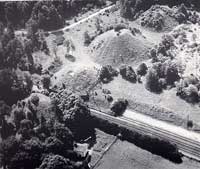
The Bartlow Hills |
|
|
There have been claims that this battle took place at Ashdon, near Haverhill, but this seems unlikely. Ashingdon, also in Essex, but nearer Maldon, would seem to be the more likely site. In 1805 Yates believed the Ashdon story and cited the legend of the Bartlow Hills. These four remarkable barrows were said to have been thrown up to hold the dead from the Battle between Edmund Ironside and Cnut, and to commemorate Cnut's victory. Today the Bartlow Hills are thought to date from around the First Century AD.
|
|
1050
|
Around this time, the local focus of power shifted to Haverhill, which was an established market town by the time of the Domesday Book, and may have had a market even around 1050. At this time the manor was held by the Saxon lord Clarenbold.
The church at Haverhill, which is later mentioned in the Domesday Book of 1086, was probably built around this time. At first it would have most likely have been made of wood, with little stone content. It stood in Burton End, the earliest known site for the town centre.
The old Roman road, later called the Via Devana, had by this time probably been diverted to the extent that it ran along Queen Street and High Street. The Burton Enders probably set up stalls along the road to sell provisions to travellers, as it was about halfway between Cambridge and Sudbury. Pack animals needed to be fed and watered, and it became known as the place where oats were grown, or in Old English, Haver Hill.
|
|
1066
|
After the Norman Conquest, William the Conqueror granted lands in Haverhill to the Bishop of Bayeux, Normandy, to Richard son of Gilbert (also known as Richard of Clare), to the "Lands of St Edmund" and to Tihel of Helean (Helion), who was also granted Helions Bumpstead.
There was already a church in Haverhill owning five acres of land. This must be the Burton End church, dedicated to St Mary.
The population, however, was small and out of the 54 male inhabitants only 19 were free men. There were 25 smallholders and "always ten slaves", and 27 pigs were recorded.
|
|
1086
|
The first mention of Haverhill proper occurs in 1086, when the Normans carried out their famous Domesday survey.
They recorded that a market was operating, and as only eleven such markets are recorded for Suffolk, it would appear that Haverhill was of considerable importance.
The local Norman lord of the manor was Tihell de Helion, although to call him a Norman may not be strictly true, as, in fact, he came from Brittany and took his name from his native village, Helyun. The Domesday Book recorded that he owned one third of the market, the remainder being given to the Gilberts of Clare. The Saxon Lord, Clarenbold, had been dispossessed in 1066. The market was valued at 13s 4d and was situated at Burton End.
As a result of the market the town proper grew up around it.
There is more about the Domesday Book elsewhere in this chronicle, and Haverhill in particular.
The de Helions continued to play a prominent part in the town and contributed to the building of the present parish church of St Marys.
The mediaeval town developed first around Burton End, where there was an eleventh century parish church, dedicated to St Marys, called Bovetownchurch. In the nineteenth century this name was probably mistakenly taken as St Botolphs.
An excavation was carried out by the Hertford Archaeological Trust at the southern end of Crowland Road, Haverhill, in March to May 1997. An ancient burial ground was uncovered belonging to Haverhill's first church at Burton End. A total of 355 individual graves were found with evidence of coffins and 'pillow stones'. There was also some late Saxon and early mediaeval pottery. The skeletons revealed most people in Haverhill lived to the age of 45, suffered from osteo-arthritis and dental disease.
The new development built on the site preserves its history in the name Overchurch Close.
|
|
c.1100
|
Some time in the 11th century Aubrey de Vere, Earl of Oxford reportedly had a 'castle' built at Castle Camps. However, the issue of what castle or castles were ever built in Haverhill is very confused and many different dates and builders have been claimed by different writers.
|
|
1123
|
The last reported wolf was seen in Haverhill.
|
|
1136
|
St Marys Church at Burton End, Haverhill, is around this time placed under the jurisdiction of Castle Acre in Norfolk, by Robert Fitzgilbert of Clare.
By now there was also the Chapel of St Mary set up to serve the new market location on Market Hill. Ther was also a chapel established around this time at the top of Ann Sucklings Lane on the way to Little Wratting. It is known as the Alderton Chapel.
The Priory at Castle Acre in West Norfolk was founded by William Warenne earlier in the century. The family were very wealthy and had links to the Clare family and the priory at Stoke by Clare. This meant that the Haverhill churches would have paid dues to Castle Acre, and that the parsons would have been appointed to Haverhill by the Warenne family.
|
|
1150
|
During the later Middle Ages Haverhill came under the sway of the De Clares and it was, perhaps, Gilbert who first built a 'Castle' here in 1275 t0 1285. What its dimensions were are not clear, but it would not have been a castle as we understand the term, having no central keep.
By the twelfth century there were manors at Haverhill, Horsham and Hanchett, and the castle although no direct evidence of this building until 1373, may well have been merely a fortified manor house rather than a fully-fledged military establishment.
|
|
1158
|
It was during this period that the association between Haverhill and London first started, preceding the present one by about 800 years! In 1158, one Brihtmarus de Haverhill moved to London and his son became Sheriff and an Alderman of the City.
Brihtmarus was a popular boy's name in the reign of King Henry I. It is also Saxon rather than French.
|
|
1160
|
Matilda, the widow of David de Cornhelle, surrendered to John, son of Peter de Haverell, her rights of ownership over a house and two stalls in Haverhill. The Market place was called the Market Hill, a Hill being a defined area, rather than a hill as we know it today. The "Hill" seems to have run along the High Street from Camps Road as far as Duddery Hill, and probably had barriers at either end so that the proper levies could be charged on anyone wanting to sell their wares. All the town's access routes were designed to traverse the market. Peas Hill may not have existed as a Pea and bean market until much later.
The High Street was originally twice as wide as it is today, in order to accomodate stalls. However, like most market places, eventually the stalls were replaced by buildings and the open area thus encroached upon. It seems that the west side has been the most encroached upon.
|
|
1180
|
Much of Haverhill and the Bumpsteads was owned by the de Helion family at this time - Robert until 1180, William, his son, until 1195 and Andrew, his son, until 1209. They can claim one knight's fee, at £10 a year.
|
|
1190
|
Michael Horne notes that in 1190, records held at Castle Acre recorded that "Master Ranulf of Harpley was instituted as parson of the church of St Mary, Haverhill, with the chapel of St Mary, in the marketplace."
This written evidence confirms that both places of worship were dedicated to St Mary, and that it is unlikely that there ever was a dedication to St Botolph.
|
|
1191
|
William de Haverhill, the son of Bryhtmaris, was Sheriff of London, and a very rich man. He gave properties to the Abbey of Westminster. We do not know od any continueing links with Haverhill.
|
|
1200
|
Little is really known about the next few centuries. The town did not appear to participate in the wool boom to the same degree as Clare, Melford and Lavenham, although weaving was always carried out.
|
|
1204
|
Thomas de Haverhull succeeded his father William as Sheriff of London.
|
|
1227
|
Isabella de Balliol sued William de Reth and his companions over the ownership of five houses in Haverhill.
|
|
1229
|
William de Haverhill was given temporary custody of the Abbey at Bury St Edmunds by King Henry III who ruled from 1216 to 1272. At the time this was the second richest place in the country after the City of London. However, this was only for a very short period while a new abbot was elected.
|
|
1239
|
Haverhill's first church was St Marys at Burton End. A second church was established in the thirteenth century on the main highway, and the town centre, together with the market, shifted to its present position. Before 1200 there had been a chapel (also St Marys) in the market place which was officially dedicated by Edmund, Archbishop of York, around 1239. Both churches were for many years under the patronage of Castle Acre in Norfolk. This is part of the present parish church. For the next 300 years there were
two churches, less than half a mile part. Burton End church was called Upper, or Bovetown (ie above town) Church, while the market place church was called Lowerchurch. Eventually in 1551 people decided they could maintain the old church no longer and petitioned King Edward VI to remove it. No trace of it remains.
|
|
1240
|
Perhaps the town's most famous son, however, was William de Haverhill, who became Treasurer to King Henry III in 1240, having already been a Canon of St Pauls. He was a great success and played an outstanding part in keeping the country on an even keel. As Treasurer he had to try to keep the king's spending within his means.
It seems likely that he was a descendant of Bryhtmarus, who had moved up to London from Haverhill around 1158. The family seems to have been very wealthy over a long period of years.
William seems to have been a favourite of the King.
|
|
1248
|
William de Haverhill, the King's Treasurer, was put in charge of London, Middlesex and London Bridge for short periods twice in 1248 and once in 1250.
|
|
1252
|
It may be significant that at the death of William de Haverhill in 1252 things began to go wrong for the King, ending six years later in civil war. A chronicler of the time, Matthew of St Albans, wrote a poem for his obituary. It included the lines: 'Never more will groaning Haverhill give birth to his like again'.
William was buried in old St Paul's Cathedral, which was burnt down in the Great Fire of 1666.
|
|
1267
|
Rabbit warrens become popular in the 13th century and free warrens were granted here to Hamo Chevre by Henry III, in 1267, and to Roger Lunedaye by Edward I, in 1281.
|
|
1275
|
It seems likely that the Castle Manor homestead was built by one of the de Clare family. This was never a castle, but was probably a moated house, possibly run as a local administration of the main castle at Clare. It was excavated in 1885.
|
|
1294
|
Haverhill's first windmill was given permission to be built, but where it was and who was likely to have operated it, are not known. Mr Dickinson thought it may have been at Mill Hill, the site of later mills.
|
|
1297
|
Around this time William Waryn of Long Melford, killed Robert le Peleter of Haverhill in a brawl. He was later pardoned on account of his good service to King Edward I in the wars against Scotland and William Wallace.
|
|
1300
|
Until the 14th century, Haverhill was an agricultural town, with its weekly market, and two annual fairs held on 12th May and 10th October.
|
|
1314
|
The last male representative of the Clare family was killed at the Battle of Bannockburn on June 24th. The manor of Clare, and with it all the holdings in Haverhill, passed to the Stafford family. The Staffords were to become Dukes of Buckingham.
Castle Manor at Haverhill thus passed to the Staffords.
|
|
1315
|
The early 1300's had suffered bad weather, and from 1315 to 1318, a great famine occurred when harvests failed.
|
|
1316
|
A strange event occurred when one Dionysia de Haverhill was kidnapped on the highway at Stapleford, between Cambridge and Sawston. She was the widow of Ralph Huntingdon, a Lord of the Manor of Sawston, who lived at Huntingdon Hall off Sawston's main street. In 1314 she married again to Geoffrey de Haverhill, and possibly they continued to live at Huntingdon Hall. They were recorded as living in Sawston by 1327, so she may have been near home when abducted.
Her kidnappers included the vicars of Sawston, Stapleford and Heydon, and she was released when a ransom was paid.
|
|
1320
|
During the next two centuries the town hardly progressed, if we are to take the population figures as a guide. In 1320 the number stood at 420.
|
|
1327
|
King Edward III wanted to renew the war with Scotland. He levied a tax or subsidy of one twentieth on all the leading citizens in the country to pay for it. This was in the parliament at Blackfriars at the time.
Thirty two leading townspeople in Haverhill paid a total of £4 11s 6d (£4.58) in taxes to assist King Edward III in his war. The record lists the town as Avrill, much as it is still pronounced by local people today.
The largest payer was Alice Chaunterel at 12 shillings, followed by Hugo Dandele at 10 shillings and Annor Simond at 5 shillings and 7 pence farthing.
|
|
1330
|
Around this time the St Mary's church was rebuilt on a larger scale than hitherto. The tower was first built some distance to the west, and then two arches were built to connect it to the church. Further work would follow later in the century.
One Godfrey of Chevelstone was involved in the purchase of a mill at Stonmelsbrigge. Chevelstone seems to have been Coupals, and the mill was at Stone mill bridge, but where that was is unknown.
|
|
1333
|
John and Agnes Curpayl were living in Sturmer. They later give their name to Coupals.
|
|
1338
|
Haverhill Castle is a great mystery. There are many theories and the earliest reference in 1338, only mentions 'Castellgate'. Later, it is 'called' the 'Castel' or 'Castelhall', like an ordinary house pretending to be something bigger. In 1800 no trace remained, but Mr Harding reported in 1977 he had seen a picture of the Castle in a pub in the 1930s. It had two round towers, a straight central section, was 30ft high and 70ft long. The supposed site of The Castle is now a
recreational area with the newt pond, possibly ancient, and play equipment.
|
|
1341
|
The Inquisitiones Nonarum aimed to assess the property holdings of all the clergy in the country. The aim was for local worthies to assess the vicar's properties and report to the crown . Four local men were identified for Haverhill, being John Clobbe, Walter de Cornhill, William de Cornhill and William atte Lete.
Thay found that the vicar, Edmund de Ketilburgh had £70, to be taxed at one ninth or £7 13 shillings. This seems a huge sum compared to the tax roll of Haverhill in 1327.
The first mention is made of a shop in Haverhill. It is managed by John le Baxtere, who paid 3d rent.
|
|
1345
|
Gilbert Godefrey of Haverhill, a prisoner in the Fleet, London, was pardoned by King Edward III at Westminster, for his outlawry in connection with a crime against Agnes Colbayn of Fynchyngfeld.
|
|
1349
|
In 1349 the Black Death reached East Anglia.
There is no direct evidence of the Black death in Haverhill, but none of the skeletons excavated at Crowland Road are later than 1350, and the family names seem to change drastically after this period.
This may mean that churchyard at Burton End ceased to be used, and burials were all done at the chapel in the market place after this date.
Around the middle of the 14th century, Haverhill was starting its ascent to being one of the lesser wool towns of Suffolk. It was close to Clare and Lavenham, and may have been rather more important in this regard than today we might suppose.
|
|
1357
|
The first real map of England is the Gough map dating from about 1357. Haverhill is marked on this map halfway between Coggeshall and (Saffron) Walden.
|
|
1381
|
During the Peasants Revolt John Hanchache (or Hanchet) from Shudy Camps, led a group of rebels to attack Cambridge University.
|
|
1392
|
St Mary's church was given to the Cluniac monastery of Castle Acre in Norfolk, in 1392.
|
|
1411
|
There is a document written in Norman French by the Earl of Oxford in his castle at Hedingham. It relates to property he owns in what is now Hazel Stubb. He was also Lord of Castle Camps. This document is unusual as Norman French had largely died out in legal documents 50 years earlier.
|
|
1425
|
John Tomeson and John Payne attacked two officials of the Countess of Gloucester in Haverhill market place.
|
|
1434
|
Two morality plays, known as the Winchester Dialogues, were written in the Essex-Suffolk border dialect, quite possibly in Haverhill. One is called Lucius and Dubius in which a master tries to teach elements of religion to a pupil. The other tries to show how Occupation is better than idleness.
|
|
c.1450
|
During the later Middle Ages, Haverhill prospered, and was featured prominently on 14th and 16th century maps of England, much more so than some of its neighbours like Linton, Clare and Sudbury.
Records of the market in the reigns of Henry V and Henry VI (1431 - 1461) give evidence of a significant trading centre, with shops and stalls selling meat, fish, cloth, small goods, lace etc and traders coming in from places like Hundon and Steeple Bumpstead.
Haverhill was also a minor centre of the woollen industry and became a weaving town, a characteristic it maintained for several centuries.
The Queens Head is one of the oldest buildings in Haverhill; its medieval roof remains. It probably dates from the 15th century, when the Saturday market was very active and "many Inns abut upon the Highway leading from the market to Cambridge and other Townes". The lands belonging to these inns were known as "ye Market Meadowes". In addition to the Queens Head, the Bull, the Bell, the Crown (in Crown Lane) and the White Lyon were prominent. In later centuries the Queens Head, popular to this day, became notorious as the final resting place for drunk drivers and the favourite haunt of disreputable clerics.
St Mary's church had further improvements made to it in this century.
|
|
1451
|
A fish seller called Cranford, from Steeple Bumpstead, and a peddler called Fisher from Hundon were fined 12d (5p) for selling fish and sprats at an excessive price in the Haverhill market.
|
|
1452
|
The Guild of All Saints was founded in Haverhill. This was one of four guilds known to have existed in Haverhill. These would have operated a bit like Friendly Societies today, giving mutual assistance to members while upholding religious and moral principles. The other Guilds were St Mary's, The Holy Trinity and St John the Baptist. Holy Trinity was founded in 1466.
There were two guildhalls, one near the old church at Burton End, and one was on the site of the Post Office.
|
|
1453
|
William Dene and Joseph Marryon of Hundon were fined 11d (4½p) each for selling "corrupt and abominable" fish and salmon in Haverhill market, "to the great damage", presumably of the public.
|
|
1474
|
John Wytchbawde paid Henry Turner 8d (3p) for a shop in the market place measuring 22 feet by 6 feet.
|
|
1480
|
A farmer called John Wagg built a farmhouse in the Essex part of Haverhill, probably in open farmland at the time. This house was added to over the years, but is today incorporated into what is now known as Anne of Cleves House.
|
|
1483
|
The Duke of Buckingham, of the Stafford family of Clare, was executed for treason by Richard III. He also owned Castle Manor in Haverhill.
William Wytchbawde was fined 3d (1p) for allowing his dunghill to "lye in the market place amongst the stalls to the great annoyance of the whole towne".
|
|
1520
|
By 1520 the population had only increased to 560. The main reason for this was the Black Death. In the years 1346 and 1360 severe outbreaks wiped out a third of the population.
A riot in the streets between Michael Matthew and Robert Cornwall and their supporters was considered so serious that it was taken up in the Star Chamber Court at Westminster.
|
|
1527
|
Thomas Turner of Haverhill was very active in the apprehension and examination of non-conformists in the area. Eight Lollards were discovered at Steeple Bumpstead and were tried for heresy.
|
|
1538
|
St Mary's was held by the Cluniac Monastery at Castle Acre until the Reformation. In 1538 all these revenues were acquired by Thomas, Lord Cromwell.
In November 1538 the King's agent Richard Ingworth arrived at Clare to receive the surrender of Clare Priory from the Austin Friars. The friars were pensioned off like many other houses, and that was that, except that in this case, the Augustine Order would return to the same spot in 1953.
|
|
1539
|
Ten bold men sign up for Henry VIII's army in the Muster Rolls. The three archers include John Cornell, and the seven billmen Richard Craknell and Hugh Mylksope. Haverhill could send two bows, two horses, two harnesses and two sheaths of arrows. Withersfield managed to find 11 men and Hundon 13.
|
|
1540
|
On the attainder of Thomas Cromwell, all the revenues he held, including those of St Mary's in Haverhill, reverted to the Crown.
|
|
1541
|
In the sixteenth century the town continued to flourish.
It obtained a royal connection on January 27th 1541, when the parsonage, lands and right to appoint clergy were granted to Henry VIII's fourth, and recently divorced wife Anne of Cleves.
Anne of Cleves, the unfortunate fourth wife of Henry VIII, arrived in England in 1539 and married the King in 1540, though the marriage was never consummated. By July she was officially divorced. In January 1541, she was given the parsonage house at Haverhill, and the right to appoint clergy. She also received a large amount of property in Sussex, Essex and other counties. She never came to Haverhill, preferring to live at Lewes, Sussex. It is probable that the parsonage given to Anne was burnt down in the fire in Haverhill in 1667. The house which today bears her name and is probably the finest building in the town today, was built in 1480, and did not become a vicarage until much later. It seemed to acquire the name of Anne of Cleves House as late as 1967, when it was put up for sale by an enterprising estate agent. It was recently occupied by American security firm HID Corporation Limited, but was on the market again in 2002.
|
|
1550
|
However, as the sixteenth century progressed things began to improve. A boom in agriculture brought more prosperity to the area and Haverhill, with its market, shared in the general increase in wealth, and the erection of permanent buildings along the line of the market gave it the appearance of a town for the first time.
The line of the town was probably from Withersfield Road, along Queen Street, High Street and Hamlet Road by this time.
|
|
1551
|
In 1551, the people requested that the old St Marys church (previously referred to as St Botolphs) at Burton End be abandoned, and it was pulled down. Nothing of the original Burton End settlement now remains, though an excavation carried out in 1997 by the Hertford Archaeological Trust, uncovered many ancient skeletons and funeral relics. Pigot's Directory of Suffolk for 1830 stated that ruins of this church were still visible at that time.
This event was recorded in the Calendar of Patent Rolls, 5 Edward VI, Part III as follows:-
May 12th 1551: "...Whereas the inhabitants of Haverhille, Suffolk, have informed the King that of the two churches in that town which are situated not far from each other, that the one called the Overchurche alias Bovetownechurch (Botolph) is too small to hold all the parishioners, and is difficult to access; whereas the other church called Netherchurch (St Marys) is large enough for all, and conveniently situated, that the inhabitants are not able to repair and maintain two churches, and that the patron and rector of the said litte church agree to its dissolution ... and unite the parishioners to the Netherchurche which shall then be the parish church of the whole town, and its rector shall have the tithes and profits previously enjoyed by the Rector of the Overchurche."
|
|
1555
|
The town did not escape the religious upheavals of the times. In September 1555, under Mary Tudor, Thomas Cobb, a butcher from Haverhill, suffered martyrdom at the stake at Thetford for his Protestant faith.
|
|
1575
|
About this time Samuel Ward, eldest son of John, was born in the Hamlet.
|
|
1578
|
Queen Elizabeth I passed through Haverhill on her way from Horseheath Hall to Kedington Hall.
|
|
1584
|
Suffolk was one of the leading areas in the puritan clergy movement. Over 60 clergy in the county refused to comply with the order to wear surplices.
|
|
1602
|
A well known local puritan preacher called John Ward died, leaving three sons who were also preachers. Samuel Ward School is named after one brother. Another brother had a son who had a hand in founding Haverhill in America.
|
|
1605
|
Ipswich had been appointing Puritan town preachers since the time of Queen Elizabeth. The most notable of these was to be Samuel Ward, the son of John Ward, the Puritan preacher from Haverhill. At the age of 28, Samuel was appointed Town Preacher for Ipswich on 1st November, 1605. His uncompromising views on how the Reformation should be carried forward were fully supported by Ipswich town and corporation, and he remained in this post until his death in 1640.
|
|
1615
|
Samuel Ward's first Sermons book was published.
|
|
1620
|
By 1620, Haverhill had become well known as a Puritan town. It produced many leading Puritan preachers such as the Ward family (John, his sons Samuel and Nathaniel and his grandson John), the Faircloughs and the Scanderets.
|
|
1623
|
A notable Puritan in the Haverhill area was Sir Nathaniel Barnardiston, who had the gift of three Suffolk livings, at Barnardiston, Kedington and Great Wratting. In 1623 he appointed Samuel Fairclough as Rector of Barnadiston. Fairclough was a famous puritan preacher, "mighty in the scriptures".
|
|
1624
|
A rental survives from this period of Haverhill in the Records Office at Bury St Edmunds. It tells of many fine houses with gardens and orchards. There were almshouses in Queen Street, and a Guild Hall and Chauntry House. Many houses clustered around the church at this time. Post Office Lane was the main route to Kedington. These properties would all be swept away by the Great Fire in 1667.
|
|
1630
|
Sir Nathaniel Barnardiston appointed Samuel Fairclough, his fiery puritan Rector of Barnardiston, to the living at Kedington, as Rector. The influence of such men made the Haverhill area a stronghold of Puritan values. Kedington Hall was the home of Sir Nathaniel and his servants were selected for their piety and sincerity. The house was run like a continuous prayer meeting, with psalms and prayers at every meal.
|
|
1631
|
David King and Zeth Wilsher were appointed the official town ale tasters.
|
|
1640
|
There were several emigrations to America, where Haverhill in Massachusetts, was founded in 1640. The American Haverhill seems to have been founded in the County of North Essex, originally with the name of Pentucket.
|
|
1642
|
The Civil War fighting did not come too close to Haverhill, but the consequences of the puritan revolution did.
During the Commonwealth Stephen Scandarett was to become Haverhill's most influential non-conformist preacher, and a great local opinion-leader.
The Barnardistons of Kedington were leading officers in Cromwell's army and the whole area supported Parliament against the King in the Civil Wars.
|
|
1643
|
Dr Dowsing, a zeolot against 'Popery', visited St Marys on 6th January, and, in his own words, in 1643, 'We brake down about 100 superstitious pictures, and seven friars hugging a nunn; and a picture of God and Christ; and diverse others very superstitious; and 200 had been broke before I came. We took away two Popish inscriptions with "Ora pro nobis", and we beat down a great stoney cross on top of the Church.'
Dowsing also destroyed all the old stained glass.
|
|
1645
|
A woman called Binks was accused of witchcraft and examined by John Stern, the witch-hunter, and Samuel Fairclough, then vicar of Kedington, in Haverhill market place.
|
|
c.1647
|
George Fox, a Leicestershire puritan from a weaving family began to preach about his "great experience" of God and his speeches sometimes caused a shaking or quaking in his audience. Thus began the Quaker movement or Religious Society of Friends, who would eventually become significant in Haverhill's history.
|
|
1648
|
Colchester was besieged by the Parliamentary army and finally surrendered after a two month siege.
|
|
1654
|
The Quakers had at first been a north of England movement, and in 1654 they sent a "mission to the south". Two Quaker preachers duly arrived in Suffolk, and probably came to Haverhill. They were Richard Hubberthorne and George Whitehead, and although the east of England was "stony ground for Quakerism," they started a small group in Haverhill. Anthony Appleby was the most prominent of this small group.
|
|
1655
|
The Quakers had several practices which offended the Establishment of the day. They believed that there was no need for priests and referred to church buildings as steeple-houses, reserving the word church to refer to the congregation, not to a building. They refused to bow or doff their hats to the gentry and even refused to use the
names of some weekdays and months where these derived from the names of pagan gods. In 1655 however, George Fox the Quaker leader alienated his movement from the mainstream even further when he refused to pay church tithes and the Poor Law rates.
|
|
1656
|
Two Quaker preachers, George Harrison and Stephen Hubbersty had been "witnessing to the truth" in the streets of Bury St Edmunds in December 1656. The response was hostile and none of the inns or taverns would take them in, so they headed for the home of Anthony Appleby, a Quaker living in Haverhill, to pass the night. A mob soon assembled outside the house, shouting for the men to come out. Next day the mob re-appeared, broke into Appleby's house and dragged out the two strangers, beating and kicking them to the end of the town.
The two men rode off to Kedington to lay complaints about their treatment to the local magistrate, Thomas Barnardiston. By now, Harrison was ill, partly from the beating no doubt, and partly from the winter weather and the long night ride to Haverhill. Barnardiston refused to hear their complaint because they would not pull off their hats to him, and they departed for Coggeshall. Six weeks later George Harrison died and the record book of the Society of Friends recorded "whose blood will be charged upon thee, O Haverhill".
|
|

Robert Darkin Token |
|
blank |
Around this time there was a shortage of small change, and the Civil War and the aftermath caused the authorities to defer consideration of the problem. From 1648 to 1672, tradesmen issued their own tokens for use as change, and in 1656 there were three traders in Haverhill issuing tokens. One was Robert Darkin, and the others were messrs Boram and Ewing.
Around this time a Wool House was built where wool was washed and prepared for the spinners and weavers. By now the individual lone weaver was replaced by Masters who bought up their products, and marketed them wholesale. They might also supply the woollen yarn to the weavers. The trade was becoming organised, the only difference from more modern times was that the weavers still worked in their homes and not in factories.
Names like Duddery Hill reflect an old established clothing trade. A dud was a coarse woollen cloth or shawl or wrap used by village people. The slang word "duds" used for clothes, derives from this word, but survives more in America than Britain.
|
|
1657
|
The local Haverhill puritans continued to harass the Quakers. John Sewell, a local Quaker was put in the stocks. His brother Ambrose and John Hall were seen speaking to him, and were sent to Bury goal as punishment. Anthony Appleby had goods distrained for refusing to pay his £20 tithe to repair the parish church.
|
|
1660
|
Despite oppression, there seems to have been 20 to 40 Quakers in Haverhill by the 1660's.
|
|
1662
|
The Act of Uniformity was passed by Parliament, also called the Bartholomew Act.
As a result, Stephen Scandarett, the fiery puritan preacher was ejected from his living at Haverhill. Scandarett was fervently anti-Quaker, even writing "An antidote against Quakerism". He had probably been behind incidents like the beating of the two Quaker preachers in 1656 in Haverhill. Scandarett may have continued to lead a clandestine congregation in the period from 1662 to 1672 when he would be licensed officially as a presbyterian preacher. This group represents the origins of the Old Independent Congregational Church, but the existing church of that name was not built until 1884.
Following the same Act, old Samuel Fairclough, a Haverhill native, but now Vicar of Kedington, was also ejected from his living at the age of 68.
Similar evictions occurred elsewhere, including Henry Havers the Rector of Stambourne in Essex, an incident commemorated in the poem "The Market Town", by John Webb.
|
|
1664
|
An inventory of Henry Cole "Inn Holder" revealed that his premises contained 800 gallons of beer and a shovel-board room. This was the equivalent of today's pool room, but was a form of shove-halfpenny. This was significant as games had been banned during the puritan Commonwealth era.
The textile industry at this time in Haverhill was described as being " a great trade".
|
|
1665
|
There is uncertainty surrounding the date of the great fire of Haverhill and for many years it was thought to have occurred in 1665. Today, the date of 1667 is widely accepted as correct.
|
|
1667
|
Disaster was to befall the church and town, on June 14th 1667, when a great fire started at the "Swan" and destroyed the centre of Haverhill, from Swan Lane to Duddery Hill. Parts of Queen Street and Camps Road were also affected, and St Marys was gutted and with it all the parish records. For many years it was believed that this fire was in 1665, but it is now attributed to 1667.
Buildings of note which are known to have been destroyed were Prenticehall, the Guildhall, Chauntry House, the Town House, and the Vicarage. These all stood around the Market Hill. Also destroyed were the Almshouses, the Daybell House and all the inns. The losses were dreadful, and Haverhill would not fully recover from the blow.
This was a disastrous episode and there was general hardship and distress. Although it was an exaggeration, it was said that "only one house and a pear tree remained". Begging letters were sent to all parts of the country in an effort to raise money to repair the damage. It was this event that robbed the town of its picturesque appearance, and with the shortage of money, the resultant rebuilding was of poor quality. A number of old houses at Hundon and elsewhere were taken down and re-erected at Haverhill to house the homeless. Many people are thought to have abandoned the town, leaving the ground to revert to the Lord of the Manor.
Today there seems to be only three buildings known to survive from Medieval times. These are the Rose and Crown, The Queens Head and Weavers in Hamlet Road. Ann of Cleves House seems the most notable, but mostly appears to date only from the early 17th century. However, its appearance has changed radically over the years, and parts are thought to date back to around 1480. After the great fire, even the vicar was made homeless, and the lord of the manor, Sir George Beaumont, gave the vicar permission to live in this house. The original parsonage, once the property of Anne of Cleves, is thus thought to be no more. In the 20th century the name Anne of Cleves was therefore mistakenly applied to the wrong vicarage.
Another incident of that momentous year involved a mother and daughter, Mistress and Miss Boram, who were hanged at Bury St Edmunds as witches.
|
|
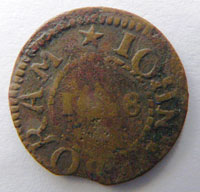
John Boram of Haverhill
|
|
1668
|
The Boram or Boreham family name was widespread in Haverhill. John Boram issued this trade token in 1668 at Haverhill.
You can see this token and more 17th Century tokens from the Haverhill area, (fronts and backs), by clicking here:
Seventeenth Century Tokens.
|
|
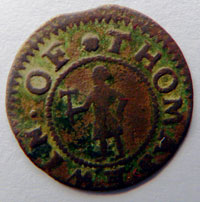
Thomas Ewin of Haverhill
|
|
1669
|
Thomas Ewin was one of the Haverhill traders who issued his own trade tokens at this time. Ewin seems to have been a Quaker, as he left a will in 1674 that endowed the local Quaker congregation with the land to build a Meeting House in Quakers Lane.
Judging by the motif on this token, Ewin was a butcher.
You can see this token and more 17th Century tokens from the Haverhill area, (fronts and backs), by clicking here:
Seventeenth Century Tokens.
|
|
1670
|
The "Essex" part of the town seems to have survived the fire, but little of the centre remained, and the parish church of St Marys was not able to be used again until 1670.
|
|
1672
|
The Act of Uniformity was repealed and Stephen Scandarett, expelled from his church living in 1662, was allowed to get a license to become a presbyterian teacher. The house of Joseph Addy became the presbyterian meeting place in Haverhill. This congregation would become the Independent Congregational church in the next century.
|
|
1674
|
Thomas Ewin died and left in his will one rood of land (a quarter acre) for a burying ground for Quakers and one rood for the erection of a meeting house. The lane leading to the meeting house soon became known as Quaker Lane. Throughout the 1660's and 1670's Quakers were continually fined and prosecuted and having goods confiscated for non-payment of tithes in Haverhill.
|
|
1680
|
A rental of Haverhill from this time survives in the Records Office at Bury. It confirms the destruction of property which happened in the fire of 1667. Not only does none of the property recorded in the 1624 rental survive, but rent levels are now considerably less than in 1624. The town was much reduced in its financial circumstances by the fire.
|
|
1690
|
The Place Farm Murder occurred. Dilly, a young parish boy, was beaten to death by Farmer Killingback. The boy's ghost was said to haunt the area for 50 years, before being exorcised by a minister.
|
|
c.1700
|
As the seventeenth century gave place to the eighteenth weaving began to expand in the town, no doubt as a result of the influence of Flemish Huguenot refugees who had settled in the eastern counties in the seventeenth century, particularly in its second half.
|
|
1707
|
One record states that the Baptists had a chapel built in Haverhill, but there is some doubt about this; and a firmer record exists for 1806.
|
|
1720
|
Unfortunately, few records survive of the post-fire period up to about 1730, though the population figures suggest that Haverhill suffered a severe decline, going down to less than one thousand inhabitants.
In 1720, the population of Haverhill was only around 600 people.
|
|
1723
|
Abraham Oakes, the vicar of Haverhill, moved to Withersfield. A great scandal broke out when he got one of his maids with child and has the baby abducted to Barnardiston.
Samuel Curteen qualified as a doctor at Cambridge and started a successful practice in his home town of Haverhill. Later he would become an alcoholic and he died in poverty in the town in 1767.
|
|
1735
|
In August 1735 John Kirby published his book called "The Suffolk Traveller". He would follow this up in 1736 by publishing a one inch to the mile map of the county, followed by a half inch scale in 1737.
The 1735 edition of the Suffolk Traveller was printed by John Bagnall at Ipswich. It contains many observations on the towns and villages of Suffolk, some of which were a bit sketchy.
Kirby gave the following description of Haverhill:
"Haverhill, or as in old records Haverhull or Haverel, is a long thorough-fare mean built town about a mile in length. The south end of the street is part in this County, and part in Essex. The north end is wholly in Suffolk. It has a mean market weekly on Wednesdays, and two fairs yearly, the one on May the 1st, and the other on August the 15th. Here is nothing in this town worthy of remark, at present: but it seems to have been larger than it is now, by the ruins of a church or chapel, still remaining."
|
|
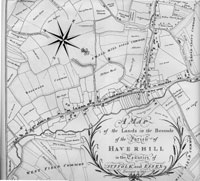
Haverhill in 1737 |
|
1737
|
A map of Haverhill was made in 1737, and a copy survives in the archives of Essex County Council in Chelmsford. The map attached is a copy redrawn by the West Suffolk Planning Officer for the purposes of drawing up the Town Plan for Haverhill, published in 1957. It may not contain all the details of the original.
The Street, (High Street), ended at a junction with Coney Lane, (Crowland Road), and Withersfield Road. Nearby was a pound for stray animals and a watermill. Wratting Road did not exist. A footpath led from Post Office Lane to the windmill and on to Chapel Farm at Boyton Hall, Kedington and Bury. Burton End was called Button End. A second animal pound was at Hamlet Green. The Manor House was set in very large grounds, inhabited by the Beaumont family. It had extensive out buildings , including the house called the Weavers. This may have been the old Manor House before the Beaumonts built or enlarged the "new" Manor House in the 17th century. Today the Beaumont's House is erroneously called Ann Of Cleves House.
The town was surrounded by huge open fields, and the ancient strip system is still shown as being in operation. By 1820 the Enclosure Acts had swept this system away.
|
|
1740
|
By the middle of the 1700s a traveller had noted that 'every cottage brought forth a clatter as the workers applied themselves to their looms.' The cloth produced was of the heavy linsey-wolsey variety used principally by the agricultural worker. It was towards the end of the century that the effect of the Industrial Revolution began to be felt. Master weavers began to appear, who bought up the finished cloth and marketed it, chiefly in London; woollen cloth giving way about this time to checks and fustians.
Checks would be used for aprons, curtains, hangings, counterpanes and gowns. The most popular was the Proud Pannell Check. Fustians were stronger and used in mens clothing, while the linseys were for womens clothes.
|
|
1745
|
Nathaniel Boreham, of Haverhill, died of a stone in his body weighing 10½ oz.
|
|
1748
|
One source states that among the master weavers of Haverhill was one Daniel Gurton (the name changing to Gurteen some forty years later), whose descendants were to have such an effect on the town for the next 150 years. The firm itself does not date its origin earlier than 1784.
|
|
1758
|
The monthly meeting records of the Haverhill Quakers recorded that John Fincham, a Quaker orphan was to be sent to the Friend's Workhouse in London, at five years of age. In 1760 he was sent to work for John Jolly at 1/- a week, and in 1761 he was apprenticed to William Roper, a last maker. This boy may well have grown up to become the prosperous merchant and dealer of Haverhill who was prominent in the 1790's. (See 1794).
|
|
1761
|
A barn belonging to John Adams was licensed for itinerant preachers, and this seems to be the origin of Methodism in Haverhill.
|
|
1762
|
John Wesley, the great Methodist preacher, recorded in his diary that he preached in a barn in Haverhill.
|
|
1766
|
Haverhill suffered a major fire, but it was not as extensive as the destruction a century earlier.
|
|
1766
|
The main Colchester, Haverhill and Cambridge road was turnpiked in 1766. News travelled faster and trade and communications all became easier and cheaper. Today's Withersfield Road was called Red Cross Road at the time.
|
|
1768
|
The Great Plague of Haverhill killed 79 people in an already depleted population.
|
|
1770
|
At the end of Hamlet Road, standing on the Stour Brook where Atterton and Ellis remains today, a tannery yard was established.
|
|
1776
|
Both 1775 and 1776 experienced fires, one of which seriously damaged Haverhill Place, later known as Place Farm.
|
|
1784
|
Gurteens' business records date back to 1784, and it is this date which the firm itself recognises as the time when the business was founded by Daniel Gurton when he "Opened Bankers with £1,000". In any event the Gurteens' business continued to prosper and soon cloth was finding its way to all parts of the country.
Daniel Gurteen specialised in weaving a material called drabbett, which was used for
making smocks which were worn by the agricultural workers of the time. We believe that he was not actually making up finished garments at this time, but sold drabbett to other makers.
It is impossible to discover exactly when the Gurton family became associated with Haverhill. While it has been suggested that the Gurtons were Huguenots of Flemish descent, certain will records show that Gurtons, Girtons and Gurdons had resided in Essex at least prior to the major Flemish immigration of the second half of the sixteenth century, and so it is possible that the name derivation is English. The earliest will recorded is that of a Gurdon in 1512. Others were recorded at Inworth, Little Waltham and Cheshunt, and near the Suffolk border at Yeldham and Dedham in 1588.
As the first Daniel Gurton - "Daniel" being the traditional family name for the eldest son - was an established master weaver, he would have been an important member of the community.
In Suffolk, weaving was still practiced as a cottage industry. Handlooms were worked at home, sometimes by agricultural workers to supplement their wages. Master Weavers were middlemen who "put out" work to the cottagers, then collected up the cloth, and acted as distributor of the heavy cloth to be made into agricultural workers clothing. Material was sent to tailors and drapers in East Anglia and East London by Gurton.
|
|
1786
|
Abraham Goodlad (23) died in a fight following a town cricket match - the first mention of the game in Haverhill. His death was lamented in John Webb's poem
"Haverhill", to be written in 1810. Webb recorded that he witnessed the stabbing.
|
|
1787
|
Labourers working on the Chalkstone Hills found a cache of ancient British coins. They were identified as from around 50 AD, with the head of Prasutagus, the husband of Boudica or Boadicea of the Iceni. It is doubtful if they would be given this attribution if examined today.
|
|
1788
|
There was a significant rift in Haverhill society over the organisation and membership of the parish church choir. The new choirmaster dismissed the old choir but they refused to go. As a result the men (old choir) deliberately sat at the back and sang the hymns half a verse behind the boys (new choir). A rude poem was later written about the affair.
|
|
1790's
|
There still survives the diaries, journals and poems of the two weaver brothers, Barnabus and John Webb, whose writings began in the 1790s.
John wrote a book of poems about Haverhill, and Barnabus was a diarist. They lived at Burton Cottage, now the site of the library, in Camps Road. They present a lively and colourful picture of a rather beautiful small town, full of interesting characters, customs and the occasional sensational event.
|
|
1792
|
John Webb recorded that he published several poems in "New Lady" magazine in 1792, but stopped writing for a while as he got married to Mehetable Browne.
|
|
1794
|
John Webb recorded that having "hitherto lived in lodgings, at midsummer 1794 I hired a small house and removed."
From 1785 to 1815 there was a long running shortage of small change. When the Napoleonic war started, what small coins there were in circulation were recalled to help the war effort. Many tradesmen adopted the idea of producing their own tokens in lieu of change. These were soon being manufactured on some scale in Birmingham in a range of patterns, usually for half pennies or penny values.
|
|
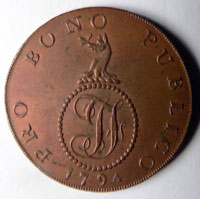
John Fincham's Penny Token
|
|
blank |
A Haverhill token, known as the Fincham halfpenny shows on one side, a man weaving with the inscription "Haverhill Manufactory". On the reverse is the crest of a Hind's head, the date 1794 and the inscription "Pro bono publico." The token also shows the initials, JF, attributed to John Fincham. This token was traded in Hull, South Shields, Chelmsford and London. The loom and motto is still used today by the Haverhill Town Council for its badge. John Fincham was a retailer, and the words "Payable at John Finchams - Suffolk" were inscribed around the outer edge of these tokens. A similar token was found in 1943 during the demolition of Ruffles Mill.
Some factory owners issued tokens to pay their own workers which could only be redeemed in the factory shop or a local store. This practice was perfectly legal until it was stopped by the Truck Act of 1844. However, most of these trade tokens were issued because of the recurring shortages of official small change. The motto "pro bono publico", was widely used on these tokens across the country in an attempt to demonstrate to the government that the motivation for issue was one of public benefit rather than base profit.
Both faces of this token can be seen, together with other local tokens, by clicking here: Eighteenth Century Tokens
|
|
1795
|
It is not exactly known how Ann Sucklings Lane received its name, and in this instance there are at least two stories. One is that in 1795 a serving maid called Alice Settling worked for a farmer called Bull. She became pregnant by him and drowned herself in shame. The road leading to her death site became called Alice Settling's Lane.
Another idea is that Ann Suckling attempted to stop the Newmarket Coach from horseback, possibly to rob it, possibly to meet a lover. However, the guard shot her dead, and her ghost supposedly stalks the Lane named after her, still on horseback.
|
|
1798
|
John Webb wrote in his diary that the organ in Haverhill church was opened. Mr C Hayward preached a political sermon on the occasion which was answered by an anonymous letter which throws light on conditions at the time. "As to the argument you advanced to show poverty is confined to a particular class of persons who bring themselves
into that state by mere indolence, I think the town in which you reside affords ample conviction of the contrary, in which are numbers who have but a scanty allowance of the necessaries of life, and this owning to the scanty pittance allowed them by their well-fed masters."
|
|
1800
|
Mrs Webb received an inheritance of £172-12s being part of the farm proceeds left by Mrs Wright of Clare. John Webb must already have been reasonably well off as he called this sum "a comfortable trifle" in his diary. In 1800 the population of Haverhill was probably around 1200 souls.
The manufacture of checks and fustians was now hit by competition from the power looms of the north. This would lead to the rise of other textiles like silks and drabbets in Haverhill.
|
|
1801
|
Haverhill's population stood at 1,104 persons.
|
|
1806
|
The town's first fire engine went into action, and an outbuilding belonging to Thomas Hales was certified for Baptist worship.
John Webb recorded that the following poem had been included in the Ladies Magazine for December 1806:
"To Mr John Webb, on reading his poetry.
Oh tuneful Webb, skilled genius, blest with such poetic fire,
Sure, every page of thines the best that fancy can inspire.
O what could equal the reward (had I poetic skill)
Of having praise from such a bard - The bard of Haverhill"
|
|
1809
|
In 1894, Crampton's almanac recorded some details of Haverhill in 1809. The almanac said the population of Haverhill in 1809 was "not more than about 1,200 and all the industry of the place was was carried on in the houses of the people and in nearly every cottage might be heard the rattle of the loom."
|
|
1810
|
John Webb's poem, "Haverhill", was published. He later became famous as the 'Haverhill poet'. He wrote that he realised 100 guineas from its publication.
William Wordsworth was said to have admired this poem and commented that he had never made so much money from his work. John Webb's patron was the Reverend Merryweather, who procured a number of "respectable subscribers" to finance publication of the poem. Webb recorded in his diary that shortly after its publication, "Sir George Beaumont called upon me and told me it did me credit and that Wordsworth, the poet, read "Haverhill" through at his house and approved of it". It was Beaumont who told Webb that Wordsworth also commented that 100 guineas was "more than I got by all my poems."
The poem was reviewed in the 'Monthly Review', the 'Gentleman's Magazine' and the 'Christian Observer'. Sir George Beaumont (1753 to 1827) owned property in Haverhill and was a widely known patron and supporter of the Romantic poets and artists like Wilkie and Landseer. He owned Ann of Cleves House and at least some of his property included the site of the 20th century Haverhill sewage works, and £100 a year of the proceeds from this land was later paid to William Wordsworth as an annuity. The Beaumont family seat was Stonehall in Dunmow, Essex, but in 1800 he rebuilt Coleorton Hall and in the London season would move to Grosvenor Square.
|
|
1811
|
The first silk production came to Haverhill, albeit in a small way.
|
|
1813
|
Daniel Gurton's son probably took over the family business in 1813.
|
|
1814
|
Drabbets arrived in Haverhill production by 1814.
|
|
1815
|
The pillory and stocks in Haverhill market place were removed.
|
|
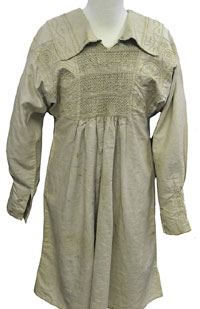
Drabbet Smock by Gurteen's
|
|
1819
|
Drabbet was now replacing the woollen cloth industry in Suffolk. At first the drabbet had a warp of hempen twine and a weft or woof of cotton. Later in the century the hemp would be replaced by linen, but at this time it remained the cheapest and toughest material for workwear. For some reason the drabbet industry had been set up in Haverhill and it remained the main centre of drabbet production in Suffolk. The hemp came from Leeds and the cotton from Stockport and was woven to produce one "chain", which took one man about a week to make. About half the weavers were women or girls who needed two weeks to make one chain.
Gurteen's records first noted the sale of ready-made strong drabbet smocks, a major leap forward in the business from just supplying drabbet, fustian and cotton cloths to other businesses. The spelling "Gurteen" instead of "Gurton" was established by 1820. The smocks would be booked out to local women to embroider the neck and sleeves with designs that denoted the occupation of the wearer. They would be collected back again and sent out to clothier's shops. Smocks had been popular in the 18th century for farmwear and were popular with waggoners and carters as well. Smocks were also called frocks at this time, and remained popular workwear in the early 19th century.
Smock production continued until the early 20th century.
The old Market House, where tolls were paid, was destroyed. The site would later be used for the Corn Exchange.
|
|
1820
|
John Webb's diary recorded that the Reverend James Bowers had died, "for upwards of the thirty years the faithful pastor of the Independent Congregation of Haverhill and was succeeded by the Revd. A C Simpson".
A map of the town dated 1820 shows that the great open fields of a century earlier had been swept away. The Enclosure movement had resulted in a new landscape of smaller, hedged fields, one which was familiar to people of Haverhill in the 1960's. Some old routes had been replaced by new, more direct roads. To beautify the changes, and perhaps to help give them a permanence, many of the roads had become lined with Poplars by 1820.
|
|
1821
|
John Webb wrote his second long poem about Haverhill, and called it "The Market Town". This poem does not seem to have been published until 1859, some years after his death.
|
|
1824
|
The silk weaving industry had been moving out of Spitalfields since about 1774. Sudbury, Haverhill and Glemsford were the places in Suffolk most affected by this migration. At first it was merely transferring the handloom weavers from one material to another, wool to silk, but following the removal of the duty on raw silk in 1824 the manufacturers began to set up throwing mills in connexion with the weaving centres.
One such throwing mill was established at Glemsford, which would be employing 200 hands by the 1870s.
|
|
1826
|
From 1826 things started to go wrong for the growing silk industry of Britain. The duty on raw silk was reduced to one penny a pound in 1825, and the silk manufacturers were assured that this move towards Free Trade would would benefit them. However, the duty on thrown silk imported from abroad was reduced from 14s 8d a pound weight in 1823 to only 5s by 1825, and then reduced further each year. Large quantities of foreign white and coloured silk came into the country, undercutting local throwers and there was an immediate reduction in employment in the silk industry of London and East Anglia. Local manufacturers were having to rely upon producing black silk, which was not greatly imported.
|
|
1827
|
Webb also reported attending a sermon in London preached "to improve the Polstead murder". The preacher "cautioned young men in the congregation against idleness, Corder was idle, and held Maria Martin as a warning against immoderate dress". This murder, soon to become known as Murder in the Red Barn was widely reported in its day. William Corder was tried and executed in Bury St Edmunds for the murder of Maria Martin in 1828, about a year after the murder.
|
|
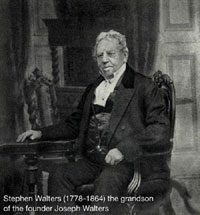
Stephen Walters - Silk manufacturer |
|
1828
|
Another branch of the textile industry also began to make a significant contribution to the town around this time, namely silk. 'Haverhill Silk' was a notice frequently seen in London's better-class drapery establishments in the early 19th century. The tanyard at the end of Hamlet Road, later to become today's Atterton and Ellis site, was bought by Stephen Walters, a Spitalfield Silk Weaver. Silk had been made in Haverhill on a small scale for some years, but this was the first silk factory in the town. A three storey silk factory was built and silk was produced until shortly before 1882 when it was sold to John Atterton.
(In 1889 silk weaving would be resumed on this site.) From 1828 to 1839 there was a great expansion in non-conformist activity in Haverhill. In 1828 the Baptists opened a new meeting house, to be followed by the Quakers house in 1834, the Methodists in 1836, the old Independents and the Market Hill chapel in 1839.
The Strict Baptist Chapel was in Downs Passage, on land bought in 1827. By 1964 the Passage had become called Upper Downs Slade.
|
|
1829
|
The year opened with a very mild January. John Webb's diary said that primroses were in bloom on New Year's Day, and it had been mild since Michaelmas.
The Market Cross and weighbridge were removed from the town centre.
|
|
1830
|
The Duke of Wellington brought in the Beerhouse Act. The idea was to halt the spread of gin consumption by allowing householders to set up beerhouses at home for the sale of beer or cider. The duty on beer was abolished as an encouragement.
Pigot's Directory of Suffolk was published for the year 1830, containing the following details of the state of Haverhill at the time:
Haverhill had just 1,649 inhabitants as at the 1821 census, and "the principal trade and manufacture in the town is in the weaving a coarse description of twilled cotton cloth, called drabbett, used principally for waggoners' frocks; there is also a silk manufactory, upon a small scale." "It was formerly a place of much greater consequence than at present, having had two churches and a strong castle; of one of the churches and the castle the ruins are still to be seen." The market was described as "a very small one" and was held on Wednesdays. There were two annual fairs, on 12th May and 26th August "for cattle, toys etc."
The silk manufacturer was Richard Roberts, the only man to be so listed at Haverhill.
However, the Drabbett Manufacturers had a small section of the Haverhill entry to themselves, and were listed as:
- Daniel Gurteen
- Samuel Nott
- Thomas Sizer
- Edward Sparkhall
- Barnabas Webb
- Stephen Webb
- Isaac Wright (& frocks)
Parry John was a "straw plat manufacturer". Straw plaiting for hats and baskets and a variety of wares flourished in these early years of the 19th century but succumbed to foreign competition in the late 19th century.
|
|
1831
|
A bare knuckle prize fight took place outside Haverhill, the magistrates having banned it from Newmarket. After 13 rounds, lasting an hour, Dutch Sam was the winner. "Such a long list of respectable blackguards never passed through Haverhill before" wrote John Webb.
|
|
1832
|
John Webb's diary recorded that on December 23rd he "arrived in London to commence business on my own account". Born in 1768, this would make him 64. His wife stayed in Haverhill, and he returned frequently, particularly for the Haverhill Fair, held for four days around May 12th.
In July 1832 there was a Report from the Parliamentary Select Committee on the silk trade. The evidence taken throws light upon silk manufacture in general but also provides evidence of the trade in Suffolk. One manufacturer called Grout, Bayliss and Co., gave this evidence. By 1831 trade had fallen off to such a degree that Grout now employed only half the hands that he had in 1825. This depression began in "July 1826 when our ports were opened for the reception of foreign manufactures, and we, at once, lost a great part of our white and coloured trade. Every succeeding year it became worse and last year we had not a single loom going, with either white or coloured crape; whereas previous to the year 1826, we had in the Spring as many looms employed on on whites and colours as on blacks; so that full one half of our trade is lost."
Not only were half the workforce dismissed but those remaining were on starvation wages. "In 1822 we paid 12 shillings for weaving a piece,.. we now pay 7shillings." East Anglian silk workers had always been paid about two thirds of the rates at Spitalfields, but even these low rates were now much reduced.
Before 1826 the workers were "very respectable in their apparel", but now "many of them have sunk into a degraded and dissipated state."
|
|
1834
|
The old Quaker meeting house had been in bad disrepair and by 1834, a new meeting house was finished in Quakers Lane, on the same land they had held since 1674.
|
|
1836
|
John Webb reported that on May 12th he visited Haverhill Fair with four of his sons. He also went "to Lady Gates Wood and gathered cowslips and cuckoo flowers in abundance". His brother Barnabas recorded that a Methodist Chapel was opened on Chauntry Croft.
The first savings bank was established in the town.
|
|
1837
|
When Queen Victoria came to the throne Haverhill was largely poverty stricken. Silk weaving had collapsed and there was no demand for old fashioned woollen products. The majority of the population were illiterate, working either on the land or on hand looms in their own homes. Housing was insanitary for the labouring classes, lacking running water or proper drainage. Local affairs were run by the Parish Vestry whose main business was administration of the Poor Laws. Streets were unpaved and unlit.
|
|
1839
|
In 1836 the congregation of the Independent Congregational Church had a disagreement over finances and a group split away to found the Market Hill Chapel where Chapmans is today. The Market chapel was finished in 1839 by the new group. This chapel later became Chapman's shop, and "1839" remains on a gable end. The original group became known as the Old Independents, and also built a new meeting house at this time.
|
|
1840's
|
Haverhill had nine beerhouses set up under the 1830 Beerhouse Act.
|
|
1840
|
Before the railway came to Haverhill, the only means of travel was by horse, carriers, stage coach or on foot. Stour Brook was never able to take river traffic. The stage coach to London, via Saffron Walden and Bishops Stortford was the "Telegraph" which left the Bell Hotel on Mondays, Wednesdays and Fridays. The "Accommodation" ran from Colchester to Cambridge, calling at the Greyhound Inn (now Lloyds Bank) on Monday, Wednesday and Friday, returning on Tuesday, Thursday and Saturday. Five carriers provided transport to London once a week from the Greyhound or the Rose and Crown. Carriers to Clare, Cambridge and Colchester ran twice a week. The Old Meeting House was built in Meeting Lane on the site
of an older church. Further building work was to take place in 1875. Barnabus or Barnaby Webb has his tomb by the porch.
The Infirmary was built behind the shops in Queen Street, in the area which is now Car Parking and the Library. It was to serve the lame and sick poor from the Workhouse on the other side of Queen Street. The Workhouse stood on Union Square which is replaced today by Queens Square precinct of shops.
|
|
1841
|
By 1841 a large brewery and maltings existed in Haverhill along both sides of Camps Road. It was owned by James Boreham to serve his pubs and to sell to others. Before such breweries, all beer was brewed by individual publicans on their own premises.
The population had now grown to 2,159, about twice what it was in 1801.
|
|
1844
|
Around this time the prominent row of 12 three storey houses that we now call Weavers Row, was erected in Camps Road. The family lived on the ground floor, and the loom was on the first floor, where there were two large windows for the light. The top floor was for stores or bedrooms. Weaving was still an industry of outworkers.
|
|
1845
|
The Haverhill Library and Lecture Society was formed by William Wakelin Boreham who was to inherit the brewery by 1864.
The Boreham family were the most important in the town in the first half of the 19th century.
|
|
1848
|
Hannah Bowyer is accused of poisoning her daughter Beatrice with boiled hemlock, but is later acquitted.
|
|
1851
|
The "British School" was built in Camps Road, a mainly non-conformist organisation, but now it is St Marys Church Hall.
|
|
1854
|
The Lancashire cotton boom, around the middle of the nineteenth century, hit the hand weavers of Haverhill hard, (although hand weaving carried on in back-garden sheds, did not finally die out until the late 1920s).
|
|
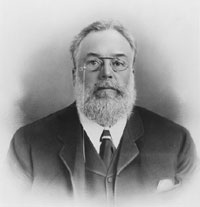
Daniel Gurteen III
|
|
blank |
In 1854 the great grandson of the founder of the Gurteen Company, also called Daniel Gurteen, entered the family business. Later, writing of 1854, he stated that: "At that time the whole town was in a most miserable condition, being looked upon as one of the most God forsaken places in the world." Often 500 men stood idle on the Market Hill, waiting for work and food. "So great was the distress that the Vestry met twice a fortnight for the purpose of finding means of sending families to Australia and elsewhere."
Also in 1854 the Haverhill Gas Company's Works was opened in Withersfield Road by the Stour Brook.
The Haverhill Enclosure Act was passed by Parliament in 1854. This was another blow to the common man as some landlords could now enclose and fence off common lands or areas where people may have gathered firewood or grazed animals, or caught rabbits in the past. A survey of 1737 had recorded Rookwood Common, Small Millfield Common, Broadcroft Common, Millfield Common and Westfield Common around Haverhill.
|
|
1855
|
A local group emigrated to Australia including the Webbs, Westleys and Marsh families.
|
|
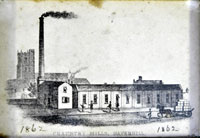
Chauntry Mill
|
|
1856
|
In 1856 steps were taken by Gurteens to compete with the mechanisation in the north. A new steam factory called Chauntry Mill was built and two beam engines were introduced to power the looms. Up to this time most of their workforce worked in their own homes, either at hand looms or making up ready made clothing. The new factory had 32 power looms. The new material was now steam drabbet, a course but hard wearing linen-like material used for smocks, the working clothes of most rural workers. It was the denim of its day and Haverhill became a famous centre for the making of drabbet smocks. (A new pub, called the "Drabbet Smock" would be opened in 1999, acknowledging its importance for the town.) Drabbet was a mixture of linen and cotton.
This, and the coming of the railways in 1863-65, laid the foundations for increasing job security and prosperity for the town for the next sixty years.
|
|
1857
|
The Corn Exchange was built in the High Street, next to the St Marys Church. This was a venture of William Wakelin Boreham.
The last open fields at Haverhill were enclosed, following the 1854 Haverhill Enclosure Act.
The Methodist community of Haverhill was founded by Thomas Cole, a local preacher of Weston Colville. They first met in an old wooden bakehouse by the Plough inn in Withersfield Road.
|
|
1858
|
A new silk factory, the second in Haverhill, was built by Kemp and sons.
|
|
1860
|
With Daniel Gurteen junior as its conductor, the Haverhill Choral Society was set up, meeting at first in the Corn Exchange.
In 1860 hopes of greater prosperity were raised in Haverhill when work started on the new railway line from Halstead to Haverhill, but a further setback was less obvious.
The so-called Cobden–Chevalier Treaty was an Anglo-French Free Trade treaty signed between the United Kingdom and France on 23 January 1860. It is named after the main British and French originators of the treaty, Richard Cobden MP and Michel Chevalier. It gave free entry of all French products except wines into Britain. Meanwhile, France had to reduce its own tariff barriers.
Employment in the silk industry had reached a peak in the 1850s when about 2,000 silk throwster, dyers and weavers were employed locally around Sudbury, and up the Stour valley. However, a number of firms in the silk business would fail to survive in the decades following the Cobden Free Trade Treaty. The firms that survived this and later recessions in the silk industry did so by focussing on the quality end of the market and by specialising in a niche market. In the late 19th century a number of firms specialised in silk fabric for parasols and umbrellas.
|
|
1862
|
In 1862 the Great Eastern Railway Company was formed by an amalgamation of most of the existing East Anglian Railway companies. The new company now made plans for the completion of the lines connecting Long Melford, Glemsford and Haverhill with Cambridge and Sudbury.
|
|
1863
|
The Colne Valley and Halstead railway finally arrived in Haverhill. Their station would become known as Haverhill South when competition arrived, but at first it was just called the railway station.
The years between 1863 and 1866 became known as the time of Railway Mania, when many new lines were proposed and opened.
|
|
1865
|
The Great Eastern Railways arrived in town from Cambridge and set up their Haverhill North Station. It was more popular than Haverhill South and even the Colne Valley used it. The Prince of Wales pub was built next to the new station for use by railway passengers. Within a couple of months Haverhill was also linked up to Sudbury. At the same time as the Sudbury link went in, the Sturmer Arches were completed to link the Colne Valley railway to the Great Eastern Line. The arches were originally called Junction Bridge, and in order to make the approach embankments large quantities of soil were dug out nearby, leaving the depression known as Junction Hole.
|
|
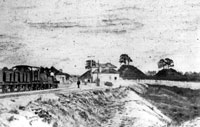
The three Bartlow Hills
|
|
blank |
There were other unwanted consequences from the construction of the new railway lines. The first station out of Haverhill, heading for Cambridge was Bartlow, where the well known Bartlow Hills stood on the route of the railway line. Excavations for the line caused further damage to these burial mounds, which dated back to the 1st and 2nd centuries AD. This picture shows a train entering Bartlow Station, with the mounds visible in the background. Within another year a new railway line was built from Bartlow to Saffron Walden, possibly with further damage to the mounds. Originally there had been seven Bartlow Hills, but only three survive to the present day.
Recognising the advantages of the new railway system for fast distribution to all parts of the country, Gurteens built a second factory of three storeys next to its drabbet mill. This housed sewing machines powered by steam driven beam engines. Vanners built a silk factory in Colne Valley Road in 1865, according to that firm. However, the Sudbury Museum Trust date this move to 1874. This factory in recent times became the Addis Brush factory. The silk was all produced on hand looms and silk looms needed very good lighting from large windows.
|
|
1866
|
The present Haverhill cemetery was begun and and opened in the following year to replace the old churchyards which were now full.
|
|
1867
|
St Marys Church was enthusiastically "restored", so that only its tower remains as clearly medieval today.
|
|
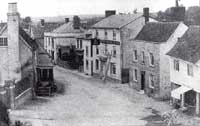
Bell Hotel 1868
|
|
1868
|
The view of the High Street shown here is believed to date from 1868. The house on the left was built in the churchyard, and has been demolished. The Bell Hotel is visible, and a similar view can be seen under the entry in this Chronicle for 1948. Beyond the Bell is a house and garden which would make way for the Co-op's magnificent new headquarters and shop in 1896. By 2000 this building was restored to become an Argos shop.
|
|
1870's
|
Taylor's Flour mill was built, to be powered by a large steam engine using a roller mill.
|
|
1870
|
This year began a burst of building activity in Haverhill which lasted for about 25 years.
This was the year of the great new Education Act, when every authority had to ensure that school places were available to provide elementary education on a universal basis. It was also called the Forster Act.
The passing of the Forster Act in 1870 brought about the establishment of Board Schools in places where there was a lack of existing provision. Board Schools qualified for government grants, and would lead to the decline of any locally established "ragged school". No action could be taken in Haverhill until a school board could be set up.
|
|
1871
|
Haverhill had a population of 3,700 and 23 pubs. The Red Lion had been a public house since at least 1685 when property deeds referred to it as the White Lyon. Today it is the site of a jeweller's shop.
|
|
1872
|
The last of Haverhill's two yearly fairs was abolished in 1872. This fair was held on October 10th, while a second, held on 12th May, had already ceased. These fairs sold goods from a wider area than the Friday Market, and were also used as Hiring Fairs for servants and farm labourers.
|
|
1873
|
Urban Sanitary Authorities came into being and the Haverhill Urban Sanitary District was set up, and its Local Board lasted until 1894. The Haverhill School Board was formed under the chairmanship of William Wakelin Boreham. The old Poor Law Unions lost all their powers to the new Sanitary Authorities. Haverhill could now start to make provision for the compulsory elementary education of its children
The monthly meetings held in Haverhill by Quakers since
1674 in their Meeting House in Quaker Lane were discontinued in 1873. Daniel Gurteen applied to buy the property, and after being allowed only to rent it, it was eventually sold to him.
|
|
1874
|
The Methodist Chapel was built in Camps Road. It replaced a series of temporary homes used by the Methodists of Haverhill since they were founded in 1857. The current building on the same site was built in 1970.
Vanners Silk manufacturers had originated in Spitalfields. According to the Sudbury Museum Trust, Vanners made a late move into Suffolk in the 1870s when they opened warehouses in Glemsford (1871) and Haverhill in 1874. Other silk firms had been active in Suffolk for over 50 years.
|
|
1875
|
John Atterton moved to Haverhill in 1875 after the firm of Atterton and Symington closed down in Halstead. He set up the Duddery Iron Works not far from the Colne Valley Railway Station at Haverhill South, casting iron and brass. Atterton's works would become a long standing feature of Haverhill employment.
|
|
1876
|
The large Board School, later known as Cangle School, was built at the junction of Withersfield Road and Wratting Road and the buildings survive there today. Such Board Schools were built under the provision of the Education Act of 1870 which made elementary education compulsory.
Steam power was successfully harnessed by Gurteens to drive sewing machines. This innovation led to the manufacture of textiles for clothing which would become the mainstay of Haverhill's prosperity into the second half of the 20th century.
|
|
1878
|
In 1878 Atterton's Patent Lawn Mower Grinding Machine was introduced to the world.
In 1878 Haverhill had its first democratically elected Local Board and a full time surveyor and they set about the task of paving the streets, lighting them and keeping them clean. A full time police force was to follow.
|
|
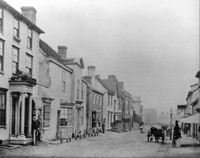
Haverhill High Street
|
|
1880
|
This picture shows the High Street in 1880. St Mary's chuch is visible in the background.
At this time the Haverhill brewery passed from the Boreham family to William Ward.
|
|
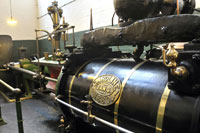
Caroline at Gurteen's
|
|
blank |
Further expansion of the local textile industry now took place.
At Haverhill,
Daniel Gurteen III invested in improved mechanisation of the Chauntry Mills by installing a modern piston driven steam
engine that remains in the factory today and has been restored to pristine condition. It was known as "Caroline", a 120hp single cylinder horizontal mill steam engine. Gurteens sold their now aging and obsolete beam engines to Walter Mason.
Gurteen also added the production of coconut matting to his output in the 1880s, and the
business expanded into the manufacture of men’s clothing, silk smocks and by 1900
the company would be employing some 2,500 people in and around Haverhill.
Gurteens had a factory outing to Alexandra Palace at the firm's expense.
|
|
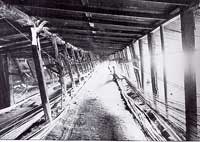
Burton End rope walk |
|
|
The Haverhill Rope Works was set up in 1880, according to the firm's own advertising sign, which can now be seen in the Suffolk Museum of Rural Life at Stowmarket. Rope was laboriously constructed in a "rope walk" which consisted of a long covered shed so that the fibres could be stretched and twisted together to build up the various thicknesses of rope.
Football was becoming an organised form of recreation for young men and the Haverhill Town Football Club was set up.
|
|
1882
|
The Haverhill Industrial Co-Op was set up, but only in a small way, in a thatched cottage in Peas Hill.
Walters shut down their silk works on Hamlet Green, and John Atterton took them over, moving his iron works operations from Duddery Road. New workshops were built and the silk factory was restored as show rooms and it was opened at the very end of December 1883.
The Local Board started on the project of a system of sewage disposal.
|
|
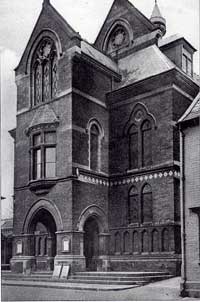
Haverhill Town Hall
|
|
1883
|
The Town Hall was built as a gift to the town of Haverhill by Daniel Gurteen Senior to celebrate his Golden Wedding Anniversary. It was quite close to Haverhill South railway station. It contained a Council Chamber and office, the Public Library and a large Concert Hall. Later it would be given a massive organ by Daniel Gurteen junior.
|
|
1884
|
The Old Independent Congregational Church was built for non-conformist worship and could seat nearly 800 people. It cost £5,800 and its fine tower and spire, about 120 feet high, were due to a gift from the late Daniel Gurteen senior. At this date it was in Essex, as the County boundary ran down the Colne Valley Road. Its spire still dominates Haverhill. Although newly built, the congregation traced its history back to 1672, or even 1662, when presbyterian meetings were held in a private house.
On May 22nd 1884 the magnificent new organ was unveiled
at the Town Hall. It cost £800 and was a gift from the Gurteen family to the town. In 1893 it had to be refurbished. Boyton Terrace was built in the Pightle. At this time the road ended in a country lane. The terrace was named after Boyton Hall, the home of Mr Fred Taylor who owned Taylors' Flour Mill immediately next door.
Gurteens began a new business of horse hair weaving but this could only be done on hand looms. They also went into fibre goods including the manufacture of crinolines.
By 1884, the gas supply in Haverhill was in a poor state. The gasworks had been set up in 1854, but since then the town had expanded ahead of the ability of the gas company to keep abreast. The Haverhill Local board complained that not all the street lights were on when they should be. Individual householders on the gas supply complained that when it was a night with no moon, the demand for gas lighting was such that their lights were no better than rush lights. Such complaints had gone on for over a year.
Matters were more complex because the Haverhill Gas Company had leased the Works to a Mr Goddard for 14 years, which expired at Michaelmas, or 29th September, 1886. Mr Goddard said that there needed to be another gas holder to meet the demand, and the existing ones needed repair. He could not afford to spend up to £2,000 if he were to lose his lease in a couple of years.
The problem remained and 58 ratepayers had signed a petition asking for a public meeting. The Local Board decided to negotiate to buy the Gas works from the Haverhill Gas Company, and made a formal offer.
The Haverhill Gas Company sold its gasworks to Haverhill Local Board later in 1884 for £2,000. It seems that Goddard kept his lease until 1886, or 1887, when the Board took over management of the Works.
|
|
1885
|
John Atterton invented the central flue kettle and was later to invent a potato cleaning apparatus in 1893, a gear for friction clutches and in 1900 jib cranes and apparatus for threshing machines.
Foundations of a building were found at the back of Weavers Row. This seems to be accepted as being the remains of the St Botolph's church, dating perhaps to a flint rebuilding of the 1100's. It was reportedly 100 feet long.
|
|
1886
|
The Police Station and Court were built on what is today Pightle Builders Merchants site. Gurteens started coconut fibre mat weaving on hand looms, as well as weaving cloth clippings into rugs.
|
|
1887
|
The Local Board finally took over management of the Gas Works.
|
|
1888
|
John Atterton received a patent for his lawn mower grinding machine and versions of this are still in use today. The local newspaper which would later become the Haverhill Echo was founded. It was called the South West Suffolk Echo until the 1960s. Around the same time the Haverhill Rovers Football Club was established. It was the second club in Haverhill, and they started to outdo the Haverhill Town Club. By 1900 the two clubs had amalgamated.
|
|
1889
|
The silk industry revived somewhat and Kipling and Co now rented part of the old silk factory from Attertons. A new Corn Exchange was built on Withersfield Road designed by Frank Whitmore. The site behind it was used as a livestock market.
The Old Independent Church received a new organ, presented by the Gurteen family in memory of old Daniel Gurteen who had died in 1884.
|
|
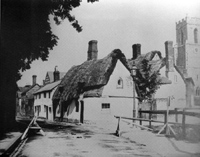
Haverhill Market Hill
|
|
1890
|
In the 1880's and 1890's Haverhill's streets were edged with cast iron kerbing brought from Wellingborough. Some still remained in Quakers' Lane until recently. This view of work on the Market Hill dates from 1890, and may even show the new kerbing being installed on the left hand edge of the picture. These houses were all swept away in the late 20th century to make Market Hill an open square once again.
By 1890 the Haverhill Choral Society was widely known and for its concert in this year special trains were laid on along the Colne Valley Line from Halstead. The Haverhill South rail station was conveniently just behind the Town Hall. It was normal for the Society to use 120 to 150 performers, of which 35 would be in the orchestra. Soloists were often engaged from Litchfield Cathedral Choir. Unhappily by 1905 there had been such a decline that the Choral Union disbanded for 20 years.
The Haverhill North railway station was well used but Station Road and the yard in front of the station was unpaved and knee deep in mud in winter. It was as late as 1890 before even a cobbled and brick path was laid to the booking hall entrance. The rest remained as mud.
The Gurteen family were non-conformist in religious belief, and in 1890 they laid the foundation stone for the Congregational School. The whole family were active in the religious, social and political life of the town.
Haverhill in Massachusetts held a celebration to mark 250 years of settlement there. Haverhill, Suffolk was represented by the Chairman of the Local Board, who was a Gurteen.
|
|
1891
|
The West End Congregational Church was built on Withersfield Road to house the growing Sunday School and congregation of the Market Hill Chapel. It could hold about 450 people. Market Hill chapel became Chapman's shop in the late 20th century. By the 1890's most of the terraced houses that were to form the majority of local homes were
built. Eden Road, Waveney Terrace, Duddery Road, Mount Road and Withersfield Road all date from this period.
In January 1891 a great occasion occurred when a shield of friendship was presented to the town by the town of Haverhill, Massachusetts, USA.
In 1891 the Haverhill North railway station was given a footbridge over the railway line and steps built down to Wratting Road.
|
|
1893
|
James Henderson was reported as running a rope works in Burton End, with a shop next to the Rose and Crown.
|
|
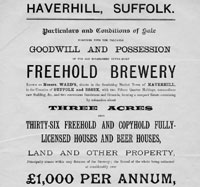
Sale of Ward's Brewery
|
|
1894
|
In January 1894 William Ward auctioned off the Haverhill Brewery with 36 pubs tied to it covering an area as wide as Castle Hedingham, Saffron Walden, Fulbourn and Swaffham Bulbeck. It had been established in the 1840s. William Ward was the owner by 1885. At this sale in 1894 the brewery was bought by Frederick Charles Christmas, and on his death in 1918 the brewery and 49 public houses were sold to Greene King & Sons Ltd. It was sold to F C Christmas for £29,100 and he owned it up to 1918. It occupied buildings on both sides of Camps Road and Upper Downs Slade, the main building is now better known as a laundry.
The Local Government Act of 1894 abolished the Urban Sanitary Authorities but replaced them by District Councils. The Haverhill Urban District Council therefore came into existence at this time. In the countryside, the Parish Councils were established, largely in the form in which they exist today.
Gurteen's built a new factory for its coco matting production which had grown apace since 1886. However in 1893 and 1894, both Gurteens who had led this expansionary period since 1856, were to die. The firm passed to another Daniel and his brothers William and Jabez Gurteen. At this time, Gurteens employed 7-800 people.
Crampton's Almanac for 1894, contrasted the condition of Haverhill in 1894, one of prosperity, with the poverty of the 1850's. It also praised the rural location, and the town's main employer. "The Haverhill people (are) enjoying the purity of the country air combined with all the advantages to be obtained by the inhabitants of a large town. That Haverhill combines these advantages is due to the Gurteens."
|
|
1896
|
As part of their ongoing work at the time, the Boundary Commission moved the whole of Haverhill into West Suffolk, under the control of Haverhill UDC. Prior to this date the Hamlet Road area south-east of Duddery Hill lay in Essex.
|
|
1897
|
The new Haverhill Co-Operative Society store was opened in the High Street, and its frontage survives today opposite Peas Market Hill. The society had outgrown its thatched cottage beginnings on Peas Hill, opened in 1882.
At St Mary's church, the vestry and organ chamber on the north of the chancel were built, and the arches of the Lady Chapel reopened.
The Haverhill Waterworks was opened, with a pumping station in Camps Road.
|
|
1898
|
The Factory Workers Compensation Act was one of a number of government measures to protect workers rights at this time. Hours of work became regulated, and factory inspectors came to visit major employers like Gurteens.
|
|
1899
|
The Haverhill Rope, Twine and Sack company was formed although Hendersons had started manufacturing these items in 1893. Haverhill Rope company had been set up originally in 1880.
|
|
1900 on
|
To follow the history of Haverhill from 1900 onwards, please click here.
|
Compiled by David Addy for the
St Edmundsbury Website
largely
from material published by the
Haverhill and District Local
History Group (HDLHG)
June 1998 to November 2002
Books consulted:
St Edmundsbury Borough Guide 1976 Edition
- articles by HDLHG and William C Blake
Haverhill Official Guide 1964 by Philip G M Dickinson
Images of England - Haverhill by Roy Brazier
The History of Haverhill by Michael Horne at
www.haverhill-uk.com/hhist.htm
"Suffolk of 100 years ago" by Humphrey Phelps 1992
The Story of a Family Firm, by D Gurteen and sons Ltd, 1973.
"Echos of the Millennium" - Supplement to the Haverhill Echo, December 1999
with research by Michael Horne
Quakers of Haverhill by L Mizon and H M Donoghue, 1984
Special research also undertaken for the
St Edmundsbury website project by Patrick Crouch and Nick Martin
Haverhill in the Middle Ages by Michael Horne, 2003
|






















